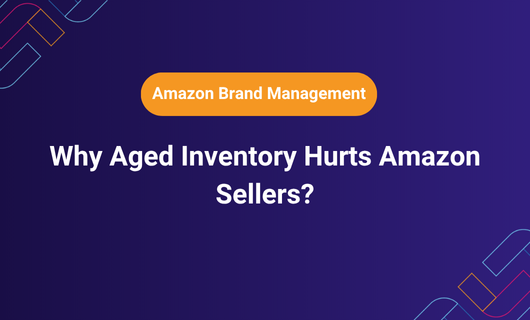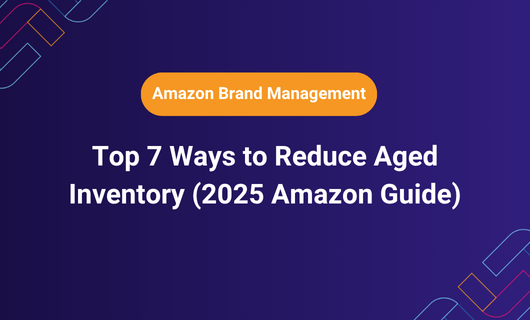
Why Aged Inventory Hurts Amazon Sellers?
If you’re an Amazon seller or manage an e-commerce warehouse, you’ve likely faced the pain of aged inventory. It starts with a few SKUs sitting a little too long, and before you know it, you’ve got rows of unsold items eating into profits. Rising storage fees, slow inventory turnover, and outdated stock can cripple your cash flow.
The pressure from Amazon’s FBA storage fees and the looming threat of a declining Inventory Performance Index (IPI) score exacerbates the situation. Stagnant stock isn’t just inconvenient, it’s expensive.
That’s where solutions like Brankit’s automated inventory aging Software Solutions come in. But before diving into that, let’s unpack the problem so you can tackle it head-on.
Brankit offers Amazon sellers a practical way to manage aged inventory and improve IPI scores, without the need for spreadsheets or manual tracking.
Learn more in our Amazon IPI Guide.
What is Aged Inventory? Causes & Costs Explained
Aged inventory refers to products that remain unsold for an extended period, typically 90, 180, or 365 days or more, depending on your fulfillment model. For Amazon FBA sellers, aged inventory triggers additional storage fees. At the same time, for warehouse managers, it results in blocked shelves and lost efficiency.
Let’s say you sell electronics. A Bluetooth speaker that hasn’t moved in six months isn’t just taking up space. It’s depreciating and relevant. Meanwhile, your newer, faster-selling products are left scrambling for room.
Inventory aging directly hits your margins by:
- Increasing storage costs
- Lowering the overall inventory turnover rate
- Causing markdowns or forced liquidation
- Hurting your Amazon IPI score
Aged inventory is more than a logistics issue. It’s a silent drain on growth.
How to Calculate the Age of Inventory?
The basic formula is:
Age of Inventory = (Average Inventory / Cost of Goods Sold) × 365
Here’s a quick example:
- If your average inventory over a year is $50,000, and your cost of goods sold (COGS) is $200,000:
- $50,000 / $200,000 = 0.25
- 0.25 × 365 = 91.25 days
- On average, your products take about 91 days to sell.
Brankit simplifies this with a built-in inventory aging tracker, eliminating the need for manual formulas. No spreadsheets. Just real-time visibility into which SKUs are aging and which are moving.
Amazon Sellers Beware: How Aged Inventory Impacts Your IPI Score?
Amazon FBA penalizes sellers for keeping stagnant inventory. Once your stock sits in their fulfillment centers for over 181 days, you incur monthly aged inventory surcharges. Go past 365 days, and the fees jump significantly.
Plus, your Inventory Performance Index (IPI) reflects how well you manage sell-through. Poor IPI scores can limit your warehouse space, especially during peak seasons.
Here’s how Brankit helps:
- Tracks aging FBA and FBM inventory
- Sends restock alerts before products go stale
- Flags stranded and long-tail inventory
- Integrates with your Amazon account for seamless reporting
WIIFM (What’s In It For Me?):
- Avoid overage fees
- Protect your Amazon reputation
- Make faster, data-backed stocking decisions

Top 7 Ways to Reduce Aged Inventory (2025 Amazon Guide)
1. Implement FIFO (First In, First Out)
Ensure older inventory is sold before newer stock. FIFO prevents long-term stagnation, especially for seasonal or perishable goods.
2. Use Dynamic Pricing
Adjust pricing based on the age of the SKU and demand. Tools like Brankit connect pricing strategies to inventory aging insights so you can liquidate before paying higher fees.
3. Prioritize Stock Rotation
Create picking systems that move older stock first. Train warehouse staff or automate workflows to enforce this.
4. Liquidate Smartly
Don’t wait until fees stack up. Utilize aged product liquidation tools or offer B2B bulk deals to offload excess inventory.
5. Create Product Bundles
Pair slow movers with bestsellers. For example, bundle an aged laptop sleeve with a trending tablet case.
6. Automate Reordering Rules
Set rules that pause reorders if a SKU isn’t moving. Brankit automates this process, preventing accidental restocks of outdated inventory.
7. Forecast Inventory Needs Using AI
Leverage predictive restocking systems to plan. Brankit’s AI helps you avoid overbuying based on real sales patterns.
How Brankit Helps Sellers Move Aged Inventory Faster?
Let’s break it down using FAB: Feature, Advantage, Benefit.
Feature: Brankit’s AI-driven aging inventory Software Solution
Advantage: Tracks product age, sales velocity, and warehouse metrics in real-time
Benefit: Know what to push, what to pause, and when to restock, all from one platform
Feature: Amazon IPI optimization tools
Advantage: Connects directly with FBA to flag inventory at risk
Benefit: Reduce penalties, boost IPI score, and increase visibility
Feature: Dynamic pricing integration
Advantage: Links aging stock with sales performance and price thresholds
Benefit: Automate markdowns and boost sell-through before items expire
For U.S.-based sellers, Brankit offers a powerful, localized e-commerce supply chain warehouse management service with actionable analytics, not just generic dashboards.
Frequently Asked Questions About Aged Inventory
What is considered aged inventory?
Aged inventory refers to products that remain unsold for an extended period, typically 90 days or more. For Amazon, stock older than 181 days is considered aged and subject to storage fees.
How to calculate aged inventory?
Use this formula: (Average Inventory / COGS) × 365. It gives the average number of days it takes to sell your inventory.
What is aged inventory on Amazon?
On Amazon, aged inventory refers to FBA stock that has been unsold for over 181 days. These SKUs may trigger surcharges and impact your IPI score.
What is another name for aged inventory?
Aged inventory is also referred to as dead stock, stagnant inventory, or overstocked items.
What is an aged item?
An aged item is any product that hasn’t sold within a specific timeframe, such as 90, 180, or 365 days, depending on your business.
How to sell aged inventory?
Utilize strategies such as bundling, discounting, liquidation, and promotions. Dynamic pricing and stock rotation also play a role.
What is the purpose of inventory aging?
It helps identify slow-moving stock, improves cash flow, and refines purchasing decisions to reduce excess inventory.
What is the golden rule for inventory?
Don’t overstock. Maintain optimal levels using forecasting, sell-through data, and rotation systems.
How to deal with aged inventory?
Bundle, liquidate, discount, or donate. Use platforms like Brankit to automate tracking and reordering decisions.
Some Final Words – Inventory That Sits, Costs. Brankit Helps You Move It.
Aged inventory doesn’t just sit on shelves. It slowly erodes your margins, reputation, and growth potential. Whether you’re a high-volume Amazon seller or a warehouse manager juggling SKUs, staying ahead of aging inventory is no longer optional.
Brankit offers a smarter, AI-powered way to monitor, forecast, and act on the age of your inventory. From predictive restocking to liquidation workflows and real-time IPI insights, Brankit is built for sellers who want to move from inventory chaos to control.
Don’t let aging stock drain your profits. Book your free Brankit demo now, and reclaim your margin.
Amazon seller? Reduce storage fees and enhance your IPI score with more accurate forecasting.
Get ahead of aged inventory before it drains your cash flow. Start with Brankit now.





